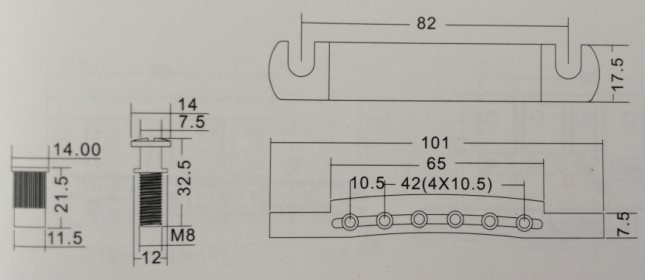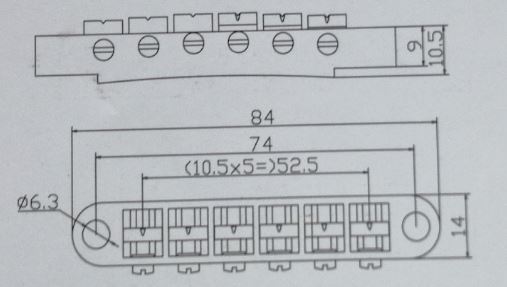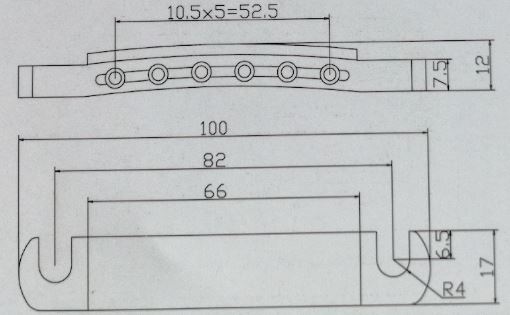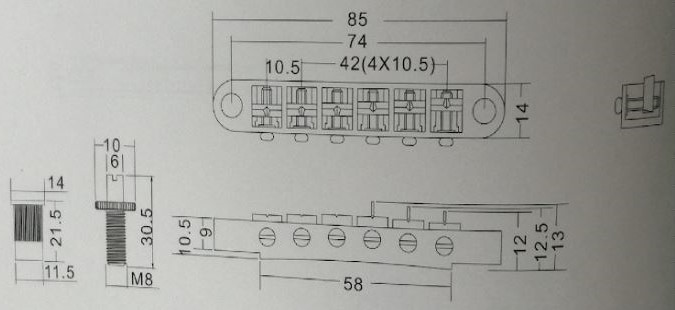Guitar Mods - Modifying Artist Guitars
General Points About Modifying Artist Guitars
This probably applies to any guitar: when you're going to put a component on a guitar, you need to make sure that it actually fits in that particular design, and not every design is interchangeable. It depends on the component that you're putting in. Generally, pickups are pretty easy, but some things like necks are very complex because there are different ways of attaching a neck to a guitar, and there are a great many variables in measurements that affect tuning and intonation; you could end up causing extra problems.
Easy Modifications
The easiest modifications are:
- Knobs
- Machine heads
- Pickup selector switch
- Output sockets
Knobs are really simple to change, machine heads are pretty easy as long as you can align them properly, and fill in or ream screw-holes in the headstock if necessary.
For information, our machine head shafts have the following dimensions:
- MSL10: 7 mm
- Electric bass: 18 mm
- Acoustic bass: 14 mm
- OMS10: 8 mm
- Electric guitars with Vintage Covered Machine Heads (Grungemaster, Baritone, Falcon): 7mm
- All other guitars (acoustic, electric, and ukulele): 10 mm
Easy Modifications but Proceed With Caution
The following parts are physically easy to change, but there are some things to consider:
- Pots (potentiometers)
- Bridges
- Pickups
- Pickguards
Our pots are all 8 mm pots, so be careful if you're replacing them with aftermarket pots. The aftermarket pots can be 9.5 mm so you might have to create some extra space (with a dremel tool or something similar) to make them fit in your control plate or pickguard.
With a bridge, you've got to make sure that it has the right dimensions to match what’s already on your guitar. For example, with a relatively simple tune-o-matic bridge, you'll need to make sure that the post size, post-hole locations, and the range of intonation are appropriate for your guitar. The dimensions also vary between guitar models.
For the LPDIY, Cherry58, and AG1:
For the LP59, BlackCherry, and BrownBurst58X:

For the LP60, LP6, LP6G, LPFDIY, and Black58:

For the AP97 and AP59GT90

Bigsby-style vibrato systems are quite a popular modification for semi-hollow guitars, but that's more difficult. Depending on the exact size of the mod, that's something where you want to make sure it all lines up correctly and there will have to be some reinforcement in the guitar for where the vibrato system attaches to the body. You have to be really careful that when you do those things, you do them correctly. I think you really want to get somebody that knows what they're doing to fit it.
With pickups, different designs of pickup have different spacing. So you sometimes have to make sure you get the spacing of the pole pieces correct. Some pickups have different sizes in terms of screw alignment and body routing, so you have to make sure you get the right size. And some pickups use two wires, four wires, or even five wires. So that can be a little bit more tricky if you don't understand the differences in the wires and how to wire it up once you've changed it.
Our Artist Bullbuckers, which are available for you to purchase, have a 5-wire setup and can be coil-split. They're available for the neck position or the bridge position, and can be covered or uncovered. These are suited to mahogany bodies and rosewood fretboards, and are a common mod job on our LP60 guitars. We use these pickups in our LP59, TC59, and Semi-Hollow Body guitars.
- Uncovered Bridge Bullbucker
- Uncovered Neck Bullbucker
- Covered Bridge Bullbucker
- Covered Neck Bullbucker
In terms of pickup routing, our guitars don't have what's called a swimming pool route. A swimming pool route is where it's just a big hole underneath the pickguard and you can put whatever pickups you want in there. All our guitars are routed to fit either single-coil, humbucker, or P90 style pickups. So if you do want to change from a single-coil to a humbucker, you have to route out the extra cavity space in the body.
With our pickguards, each model has a pickguard made for it, and that can change over time. So if, for example, we change the supplier of the pickguard, we might have a slight adjustment to where the screw holes are, or we might have slightly adjusted the way that the neck joins the body. It might not be enough that you can see that difference and it might be very minor, but when you just go and put that pickguard on another guitar, you're going to notice subtle differences in the way that it fits. We normally recommend that if somebody wants to change a pickguard, they should actually get one cut that fits the guitar they have, or copies the pickguard they already had on that guitar. It's a bit of extra work, but then you get a perfect fit. Over the years, we've used a number of different guitar factories, as we've found better factories that have better quality. So there are natural changes in the production process where parts are not exactly the same, but they're perfect for that particular model or that particular production run.
Difficult Modifications
The following modifications are a bit more tricky to get right:
- Neck
- Saddles
- Nuts
Necks
One of the more difficult ones is when you're attaching a neck. When you attach a neck to a guitar, the part of the body that the neck slots into is called the neck pocket. On different types of guitars, those neck pockets will be different heights and different widths and sometimes even different angles. If you get that wrong, the new neck won't play correctly on the new guitar. So, some people might want to put a Fender neck on an Artist Guitar, but if Fender uses a different neck pocket, that's not going to be a simple job to do.
If the new neck has more or less frets, that's also going to make it more complicated. When you have more frets on a guitar, the neck pocket is in a different position. If you go from 20 to 24 frets, the neck pocket is a different position on that guitar body so that it all lines up correctly. But if you just go and put the new neck on when the neck pocket is not adjusted appropriately, you're effectively going to make your scale length longer than it should be, and you'll always have some intonation problems. So if you are going to change a neck, you have to be very careful that it's all going to work correctly.
Another potential problem that you have is neck angle. So typically, like on a Fender style guitar, they don't have any neck angle. And some more modern guitars have a very slight neck angle. In some cases, your neck has to have some angle when it attaches to the body, otherwise the strings would just lay on top of the wood and there wouldn't be any string height there. Typically Fenders have a zero neck angle, but more modern guitars might have a half or one degree angle. And if you're using a neck designed for a Gibson, you might have four or five degrees of angle. So if you get the angle on the wrong neck pocket, you can have a lot of issues that you have to counteract to make that work.
You also need to consider the neck width. So say if you've got a 42 mm nut and a 60 mm bridge, that affects what the width of the neck will be at the 12th fret. And if you mix those things up, you'll have a situation where the strings are going off the edge of the fingerboard. And if you get the neck width wrong, it probably won't fit your neck pocket correctly. If your neck pocket is about two inches wide, and you've got a neck that's wider, it's actually going to be off-centre if you put it in that same slot. Then you're going to have strings that go in a really funny direction. In summary, if you don't have the neck width that matches the width of your bridge, then it just won't play correctly.
Neck radius is also important. If you change from our modern radius of around 12 inches, to a vintage radius of about 7 1/2 inches, you need to change the whole setup of the bridge, otherwise you're going to have lots of problems with the string action. So if you change from a flatter radius to a more vintage curved radius, it takes a fair bit of adjustment to get that right.
Nuts and Saddles
We custom fit the nut and the saddle for each single guitar that we make. So if you want to change it out, we can get the original parts, but you still need to get it fitted by a luthier to get the best result. And I would say unless you're going to get a luthier to fit it, you're better off not to change it. So say if you've got a guitar and it's got a plastic nut on it, and you want to go from a plastic nut to a bone nut because a bone nut is better. If you don't get a luthier to fit that bone nut, you'll probably make the guitar worse than just leaving the plastic nut on it. When you fit it you need to get a perfect fit, but you also need to adjust the action at the first fret to avoid intonation problems.
When you play the first couple of notes on a guitar, the thing that makes the biggest difference in the intonation is actually the height of the nut relative to the first fret. If it's too high, when you press down on the strings, you bend the string more than if it's the perfect height. That extra bending of the string causes the note to become a little sharp and the intonation goes out. So if you change the nut without getting it fitted properly, you're going to have a lot of intonation problems that you probably don't want to have.
When you fit a saddle on an acoustic guitar, it's quite a fine adjustment to get the action height right. You also need to make sure that the bottom of the saddle is perfectly flat. It's not that hard to do if you've done it a few times, but you need a specialist tool to do it properly. So if you were going to change a saddle, I would also recommend that you got somebody to fit that that knew what they were doing.



